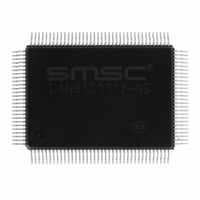LAN91C111I-NS SMSC, LAN91C111I-NS Datasheet - Page 34

LAN91C111I-NS
Manufacturer Part Number
LAN91C111I-NS
Description
IC ETHERNET CTLR MAC PHY 128-QFP
Manufacturer
SMSC
Type
Single Chip MAC and PHYr
Datasheet
1.LAN91C111-NU.pdf
(128 pages)
Specifications of LAN91C111I-NS
Controller Type
Ethernet Controller, MAC/PHY
Interface
Serial EEPROM
Voltage - Supply
3.3V
Operating Temperature
-40°C ~ 85°C
Mounting Type
Surface Mount
Package / Case
128-QFP
Product
Ethernet Controllers
Number Of Transceivers
1
Standard Supported
IEEE 802.3 or IEEE 802.3u
Data Rate
10 Mbps or 100 Mbps
Supply Voltage (max)
5 V
Supply Voltage (min)
0 V
Supply Current (max)
140 mA
Maximum Operating Temperature
+ 85 C
Ethernet Connection Type
100BASE-T or 100BASE-T4 or 100BASE-TX or 10BASE-T
Minimum Operating Temperature
- 40 C
Mounting Style
SMD/SMT
Lead Free Status / RoHS Status
Lead free / RoHS Compliant
Current - Supply
-
Lead Free Status / Rohs Status
Lead free / RoHS Compliant
Other names
638-1014
Available stocks
Company
Part Number
Manufacturer
Quantity
Price
Company:
Part Number:
LAN91C111I-NS
Manufacturer:
RECOM
Quantity:
1 000
Company:
Part Number:
LAN91C111I-NS
Manufacturer:
SMSC
Quantity:
1 000
Company:
Part Number:
LAN91C111I-NS
Manufacturer:
Standard
Quantity:
6 916
Company:
Part Number:
LAN91C111I-NS
Manufacturer:
Microchip Technology
Quantity:
10 000
Revision 1.91 (06-01-09)
TP Squelch - 100 Mbps
The squelch block determines if the TP input contains valid data. The 100 Mbps TP squelch is one
of the criteria used to determine link integrity. The squelch comparators compare the TP inputs against
fixed positive and negative thresholds, called squelch levels. The output from the squelch comparator
goes to a digital squelch circuit which determines if the receive input data on that channel is valid. If
the data is invalid, the receiver is in the squelched state. If the input voltage exceeds the squelch
levels at least 4 times with alternating polarity within a 10 μS interval, the data is considered to be
valid by the squelch circuit and the receiver now enters into the unsquelch state. In the unsquelch
state, the receive threshold level is reduced by approximately 30% for noise immunity reasons and is
called the unsquelch level. When the receiver is in the unsquelch state, then the input signal is
deemed to be valid. The device stays in the unsquelch state until loss of data is detected. Loss of
data is detected if no alternating polarity unsquelch transitions are detected during any 10 μS interval.
When the loss of data is detected, the receive squelch is turned on again.
TP Squelch, 10 Mbps
The TP squelch algorithm for 10 Mbps mode is identical to the 100 Mbps mode except, (1) the 10
Mbps TP squelch algorithm is not used for link integrity but to sense the beginning of a packet, (2) the
receiver goes into the unsquelch state if the input voltage exceeds the squelch levels for three bit times
with alternating polarity within a 50-250 nS interval, (3) the receiver goes into the squelch state when
idle is detected, (4) unsquelch detection has no affect on link integrity, link pulses are used for that in
10 Mbps mode, (5) start of packet is determined when the receiver goes into the unsquelch state an
a CRS100 is asserted, and (6) the receiver meets the squelch requirements defined in IEEE 802.3
Clause 14.
0
Figure 7.5 TP Input Voltage Template -10MBPS
585 mV sin (2
0
PW/4
585 mV sin (
Slope 0.5 V/ ns
Slope 0.5 V/ ns
585 mV sin [2
a. Short Bit
b. Long Bit
*
DATASHEET
t/PW)
34
*
t/PW)
(t - PW/2)/PW]
3PW/4
P W
10/100 Non-PCI Ethernet Single Chip MAC + PHY
3.1V
585mV
PW
585mV
3.1V
SMSC LAN91C111 REV C
Datasheet













